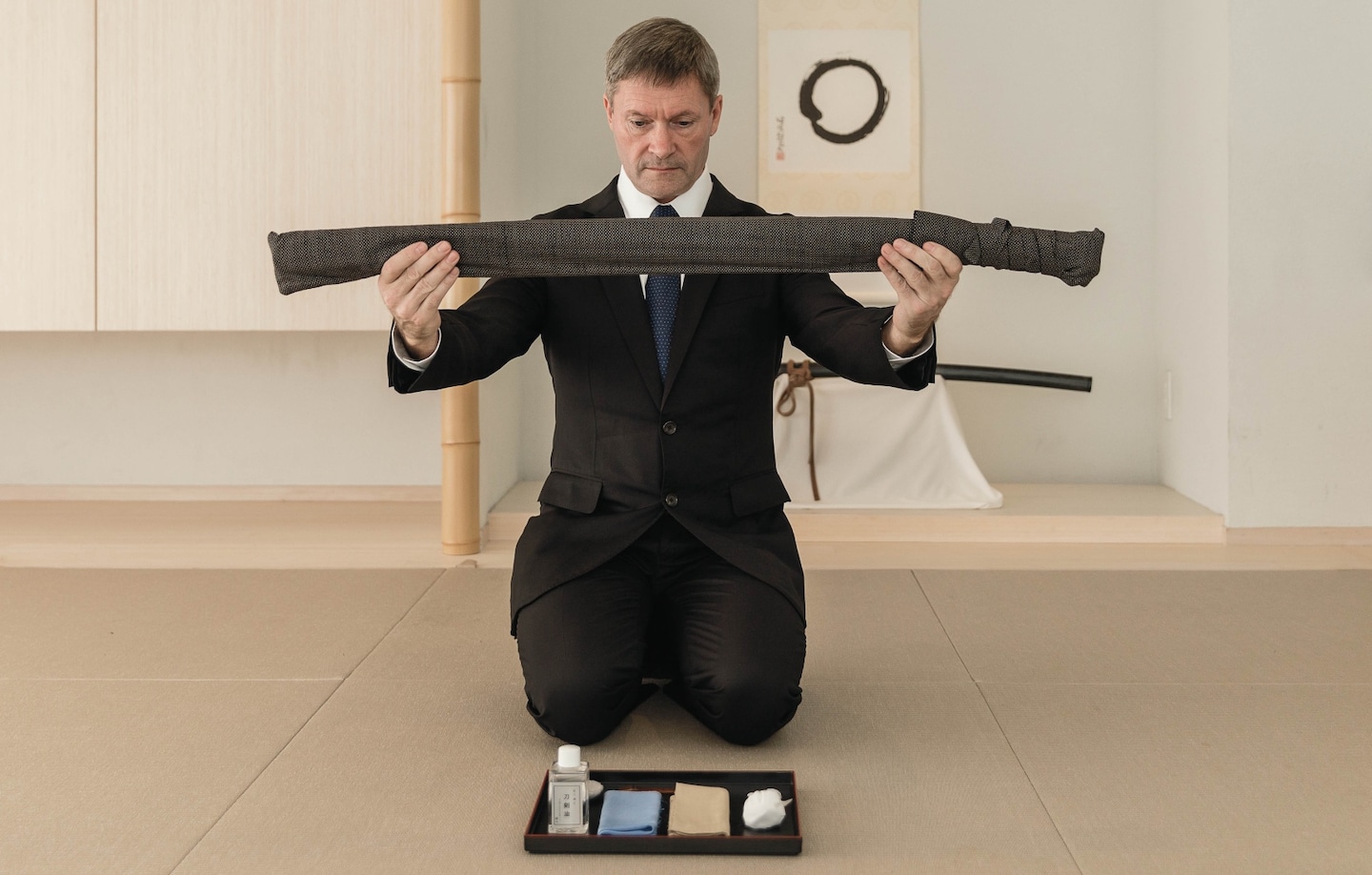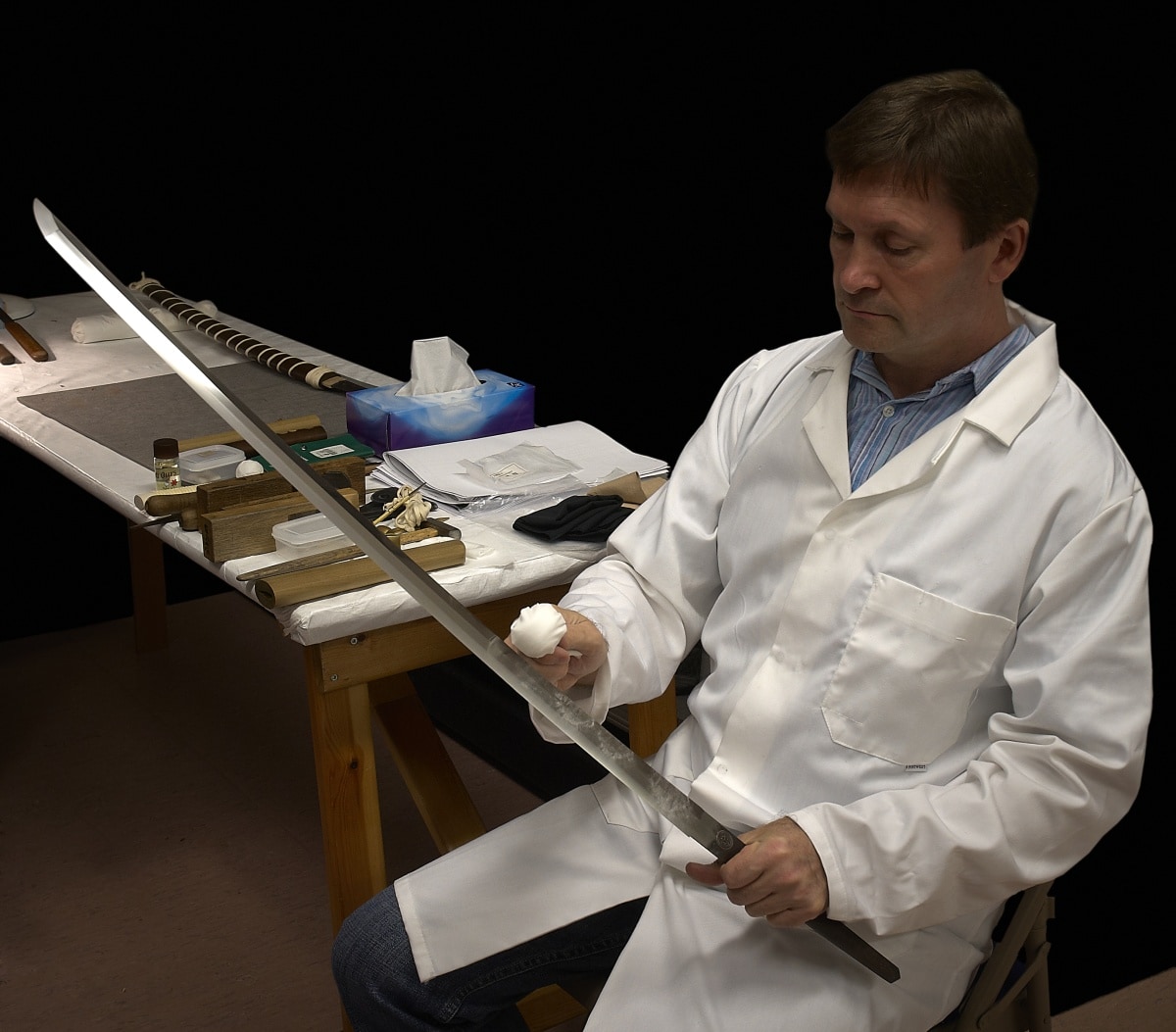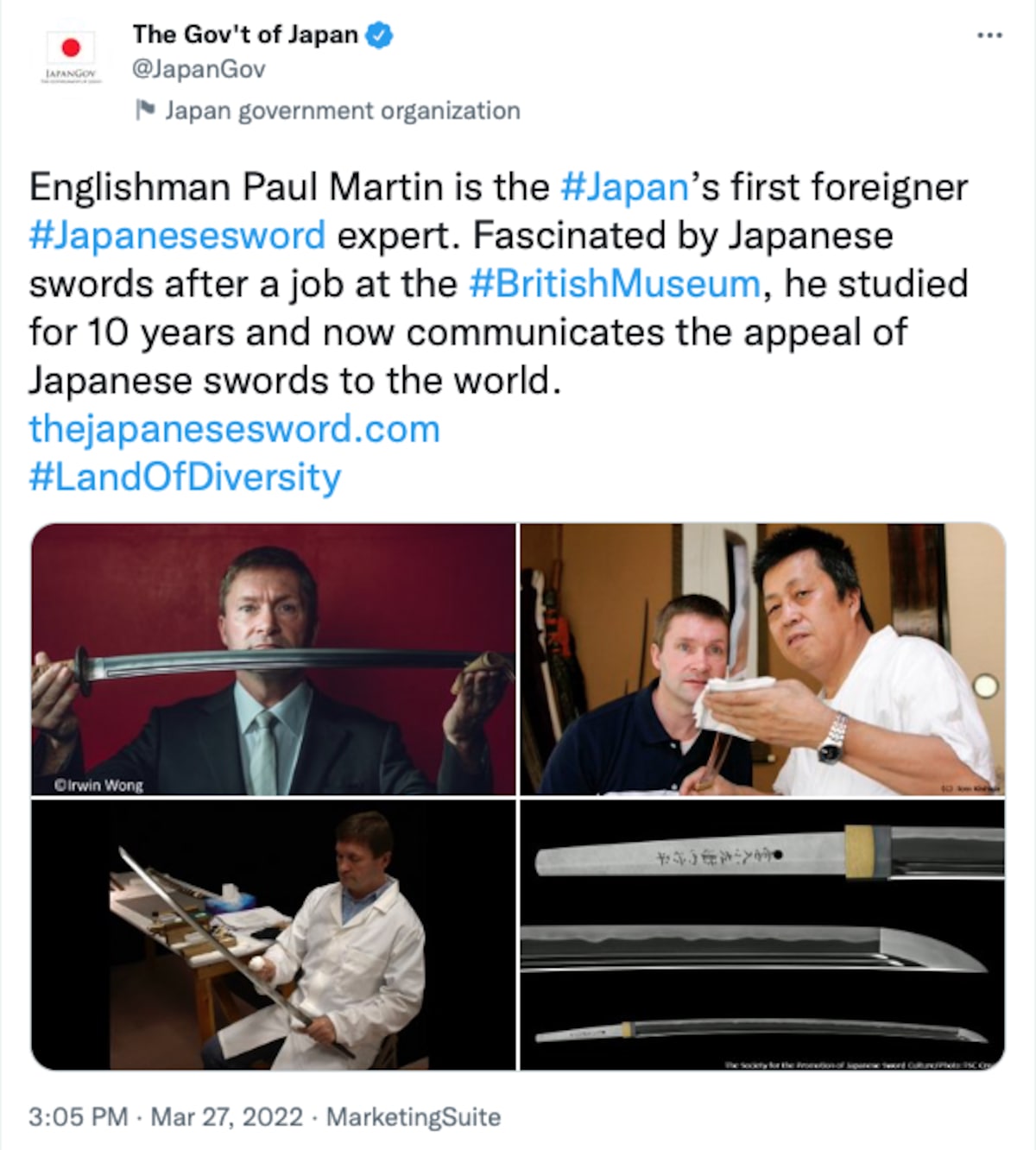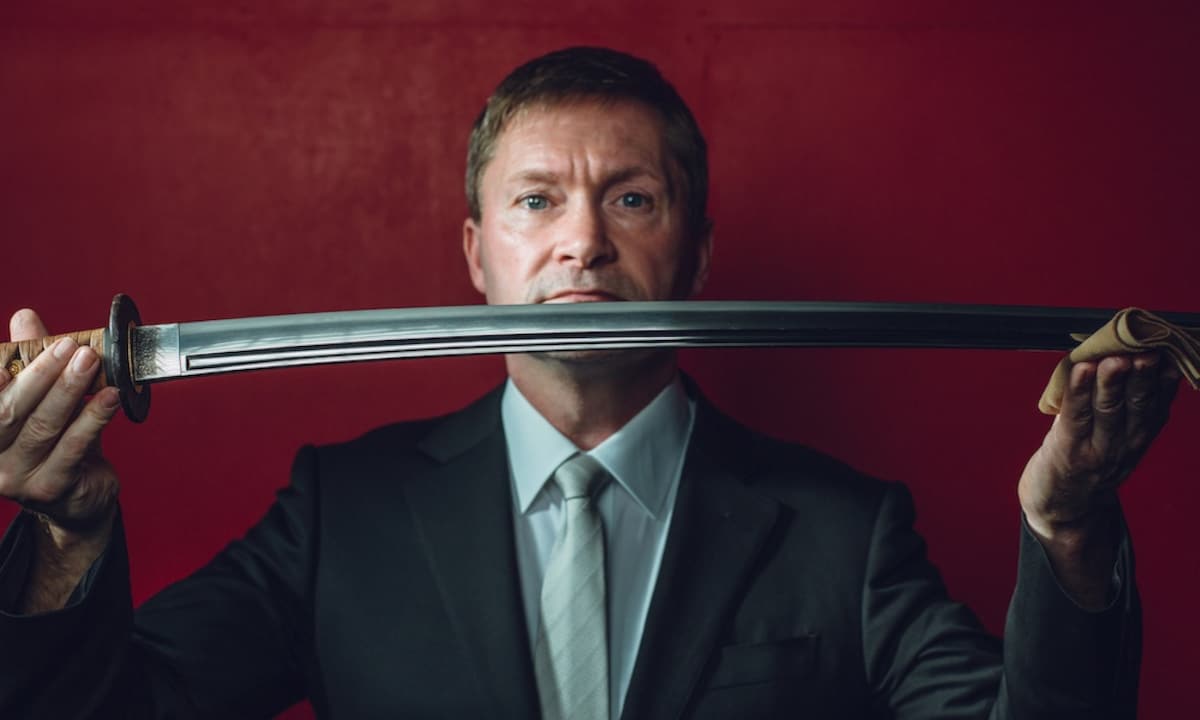Japanese Sword Expert Paul Martin and his "Demon Slayer" Project

Paul Martin is the first foreigner recognized as a Japanese sword expert by the Japanese Government and the first foreigner to be appointed as a trustee for a major Japanese sword craftsman's public foundation. (Lead photo by Steve Morin).
By Mac Salman
Paul Martin at the British Museum
He has written books, consulted on movies and made many TV appearances, all aimed at opening up the world of katana and more to an international audience. We sat down with him to get the inside scoop on his background, current projects and future plans.
Tell us a bit about your background. When did your interest in Japanese swords first start?
My father used to practise karate when I was small. I began karate at age seven. Growing up I would hear phrases like “samurai spirit” and “bushido,” which basically means “don't give up,” and “have courage and be forthright.”
As you got older, did this interest in Japanese culture grow?
When I became a teenager, I was introduced to the movies of Kurosawa Akira. I saw another movie called The Yakuza (1974) starring Japan's greatest actor, Takakura Ken. I was profoundly moved, and my interest in Japan deepened greatly.
What was your first encounter with swords?
I became a security guard at the British Museum in 1992. When I went into the Japanese gallery, I saw real Japanese swords up close for the first time. Someone in the gallery informed me that there was a Japanese sword specialist employed in the Japanese department. I was blown away. It had never occurred to me that such a profession even existed. At that very moment, I realised my life's dream.
When did you move to Japan?
I had visited at least once a year since 1998 as a representative of the British Museum's Japanese Department. I moved to Japan in 2004 to further my studies of Japanese swords and deepen my understanding of sword appraisal. I intended to come for one year, but after a couple of extensions, I realised that I really didn't want to leave.
"The culture of the sword in Japan pretty much permeates the whole of Japanese culture in a spiritual and artistic sense."
A sword by swordmaker Ono Yoshimitsu
What makes Japanese swords, and the culture around them, so special?
There are similarities between samurai culture and western knight culture in that manners are very important among people who are armed and trained to be able to spring into action at any moment. However, the difference is that the culture of the sword in Japan pretty much permeates the whole of Japanese culture in a spiritual and artistic sense.
And other cultures?
They decorate swords using precious metals and jewels in the mountings. But the appreciation of the Japanese sword begins with the intrinsic beauty of the steel itself. You can occasionally find highly decorated mountings, but on the whole, they are somewhat simple, in line with the Japanese wabi-sabi aesthetic.
So how would you describe a Japanese sword?
It is not merely a weapon, it is functional art with a deep spiritual meaning. There are three major factors of a blade to be taken into consideration—the shape of the blade, the pattern and hues of the surface steel, and the pattern of the differentially hardened edge. When these three factors are perfectly harmonized, the result is regarded as a masterpiece. Also, the resulting patterns of the surface steel and the hamon often combine to reflect elements of natural phenomena. This is in accordance with the Japanese appreciation of nature, leading the viewer to acknowledge that the swordsmith is not the sole manufacturer of the blade, but that he participated in a collaboration with the gods and nature of Japan.

Paul Martin featured on the Government of Japan’s Twitter account
You believe that the study of the Japanese sword is a window into the essence of Japanese culture. Can you elaborate on that?
As I mentioned earlier, the Japanese sword pretty much permeates the whole of Japanese culture. The curved Japanese sword as we know it first appeared around the mid 10th to 11th century, but the spiritual roots come from the origin myths in which the gods stirred the sea of Japan with a sacred spear, and from the tip some droplets of mud fell to form the Japanese islands. Then later, the deity Susanno slew the eight-headed eight-tailed serpent dragon: the Yamata no Orochi. In one of the tails, he discovered a sword that went on to become one of the three items of the imperial regalia - an item that was (allegedly) inside the box next to the current emperor at his enthronement in 2019!
As collectables, how has the market in Japanese swords changed over the last 15 years?
As I am an academic, I am not really familiar with the day-to-day prices of Japanese swords. Obviously, Japanese swords are very collectable items, but as with most art, markets are subject to fluctuation. However, Japanese swords also require a lot of attention and upkeep. If not stored and cared for properly, they will rust, and require restoration, which shortens the life of the blade.
Are they a good financial investment?
As a curator, it is hard for me to say. Obviously, I think that their preservation is of the utmost importance—not only the antique swords but also the intangible skills of the craftsmen that have been passed down from generation to generation. We should regard ourselves as the current generation of caretakers who are responsible for their safe passage onto future generations. So any money invested or spent in the upkeep of swords should be regarded as a small fee for the honour of having been able to look after and appreciate them during one’s lifetime.
"'Demon Slayer' introduced aspects of Japanese swords, but it also brought in supernatural stories of demons. "

Paul Martin (photo by Irvin Wong)
Tell us about the Demon Slayer projects you have been involved in?
Every generation of Japanese sword craftsmen faces a challenge: "How to maintain swords' relevance, and how to introduce them to the current generation?" Every generation has their gateway. Mine was Kurosawa and Takakura Ken movies. More recently, people have been introduced to swords via movies and manga like Rurouni Kenshin, or the online game, “Touken Ranbu.” In the last few years, Kimetsu no Yaiba (Demon Slayer) has become popular.
What made the manga series, which was later developed into a TV series and film, so popular?
Demon Slayer introduced aspects of Japanese swords, such as the raw materials, but it also brought in supernatural stories of demons. And the stories were in keeping with the Japanese psyche in that the overarching theme is that swords are used for the quelling of evil. That a sword used with a pure mind with good intentions will prevail.
And your project?
Under the guidance of a master sword fittings maker, I produced a set of fittings similar to that on the sword of the primary character. I then employed other traditional craftsmen to make the mountings, lacquer the scabbard, and wrap the handle. I uploaded the whole process on YouTube to try and attract people interested in the series to take an interest in actual Japanese swords. The prototype sword guard for the project is currently on display at Aizu-Wakamatsu's samurai academy, Nisshinkan.
What are your future plans?
Before COVID I was a TV bridge between East and West for Japanese swords. Now I am doing more Japanese TV, including a regular spot in a series on swords. I also have a few books in the works. If Japan opens up again to tourists, I will probably have my regular sword exhibition and book translations.
Outside of swords, what else do you enjoy doing?
My hobbies are pretty much sword-related. I practice Japanese sword martial arts. I also like socialising, but I tend to do it with various craftsmen and sword aficionados. I also enjoy Japanese movies and dramas, but I am very much looking forward to seeing the new Star Wars series “Obi-Wan Kenobi.” Oh, wait, that's involving swords again, isn't it?!
Paul Martin is also the founder of the Shin-Gobankaji Project which hopes to preserve the various sword-making skills and techniques and pass them on intact to future generations. It is building a database of actual works of the elite smiths of each generation as a basis for sword appraisal in years to come.
He can be found on Facebook, Instagram and YouTube, as well as at his homepage: www.thejapanesesword.com
Other "Life in Japan" Interviews
Brit Amelia Hiorns is Working to Save Japan’s Bear Population
Teenage Beer Brewer to Shochu Prophet
Englishwoman, Buddhist Priest, Country Mom
From the Way of the Warrior to the Way of Tea



